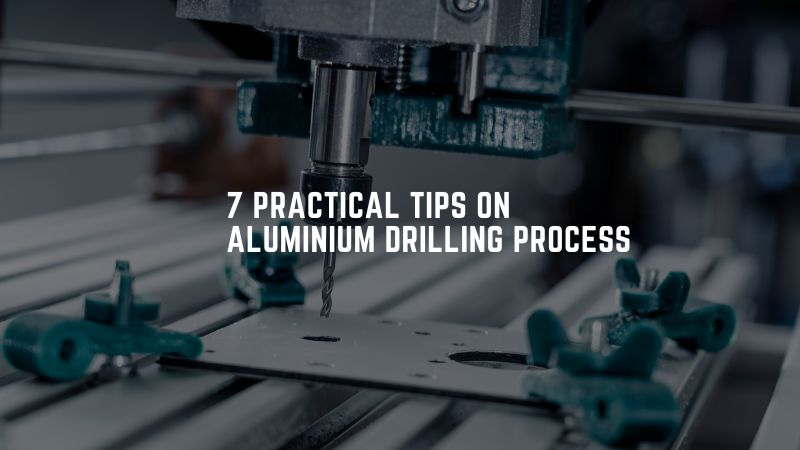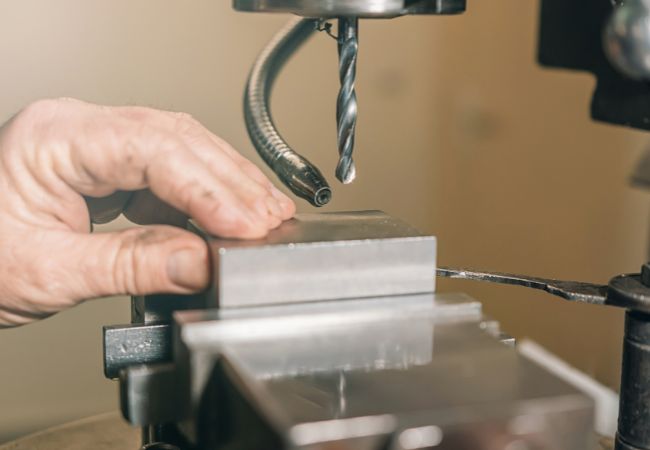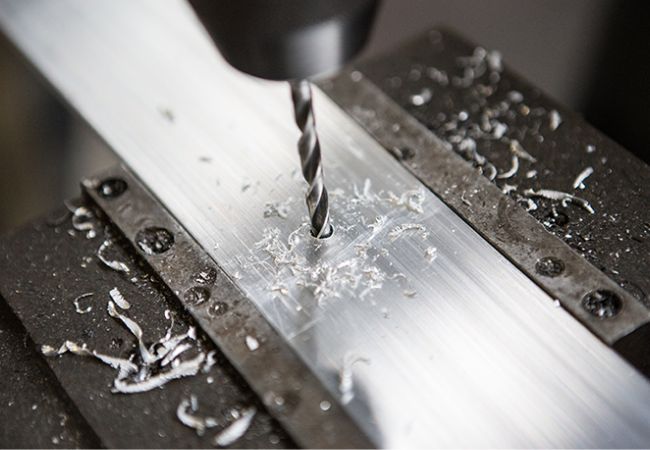
The aluminium drilling process is an essential design feature in the creation of holes for fitting components and joining purposes. The efficiency of the aluminum drilling process depends on several factors such as tool geometry, process conditions, material and cutting parameters.
This guide highlights 7 tips that will help you drill aluminum sheet successfully.
Tip 1: Choose Suitable Drill Bit

Drilling Aluminum
Several drill bits find use in aluminum drilling such as the high speed steel (HSS) drill bits and cobalt drill bits. HSS drill bits can have coating such as black oxide and titanium to reduce corrosion and friction respectively.
7075 aluminum alloy employs zinc as the main alloying component and possesses incredible toughness, strength and fatigue resistance. Tungsten carbide drill bits have incredible strength and dissipate heat faster making them ideal for 7075 aluminum.

Tungsten Carbide Drill Bit
When selecting aluminum drilling tools, the following considerations are helpful:
- Drill bit parameters such as material and coating (cobalt, tungsten carbide or HSS)
- Drill bit type including step, center, twist, conical, body, reamer or insert.
- The hole diameter.
- The bit angle and length.
Tip 2: Know the Type Of Aluminum Alloy to Drill
There are several aluminium alloys with different constituent elements that define its properties. These alloys are all available for drilling fabrication and are categorized in series as follows:
I. 1000 Series
Has over 99% aluminium content making it essentially pure aluminium with excellent corrosion resistance and high thermal and electrical conductivity. A non-coated high speed steel (HSS) drill bit and carbide drill can work well due to its soft state.
II. 2000 Series
Contain copper as the main alloying element capable of precipitation hardening to steel level strengths but hampered by corrosion stressing. Using high speed drill bits with black oxide coating helps reduce corrosion while increasing durability.
III. 3000 Series
Employ manganese and some variants have small quantities of copper, magnesium or silicon with high strength and corrosion/wear resistance. Both cobalt drill bits and titanium-coated HSS drill bits can comfortable drill holes through this material.
IV. 4000 Series
Utilize silicon as primary alloying element and offer moderate strength, reliable resistance to impact and high ductility. HSS drill bits with black oxide coating can work well with this material.
V. 5000 Series
With magnesium and manganese as the prime constituent elements, this series offers incredible resistance to corrosion and strength without heat treatment. You can employ cobalt drill bits and coated HSS drill bits during drilling process.
VI. 6000 Series
The primary alloying elements are magnesium and silicon making them easily machinable and weldable. Consequently, you can employ low strength drill bits such as HSS and carbide drill bits when fabricating.
VII. 7000 Series
Zinc is the main alloying element allowing precipitation hardening making them the strongest among the alloys. Their high resistance to corrosion and impressive surface finish makes use of cobalt and tungsten carbide drill bits feasible.
Tip 3: Choose Best Lubricant for Drilling Aluminum
A good lubricant in the aluminum drilling process should help prevent heat buildup resulting from drill bit and workpiece friction. It should also reduce excessive wear and tear of the drill bit that diminishes hole quality and even cause damage.
When drilling aluminum you can employ liquid lubricants such as water-based synthetic and semi synthetic coolants like soluble oil. You can also employ petroleum-based mineral fluids such as WD-40, isopropyl alcohol and kerosene.
Tip 4: Know Correct Safety Measures
Knowledge of correct safety measures during aluminum drilling is essential in preventing injury or even loss of life. Some of the safety measures you need to undertake include:
- Avoid manually holding the aluminum workpiece during the drilling process employing a clamp for securing instead.
- Avoid wearing loose clothes, gloves and even hair since they might rope you in by attaching to the spindle or bit.
- Do not adjust the machine while the drilling process is in progress.
- Keep the machine guard unmoved at all times.
- Let the bit perform the drilling process on its own without excessive external force application.
- Stop the machine immediately using the emergency button in case of a malfunction.
- The chuck key should never be left in the press, finding use only during bit changes with the power off. Otherwise, it can eject at great speed when powered making for a deadly projectile.
- Wear safetyy glasses to prevent eye injury from aluminum chippings.
Tip 5: Apply Reasonable Pressure to Drill Aluminum.
When drilling aluminium, applying unreasonable pressure causes a built up edge where the aluminium material sticks to the drill bit. This impairs the hole quality resulting in the need for secondary finishing operations that increase fabrication price and time.
Tip 6: Know Drilling Aluminum RPM And Feeding Speed
The feed and speed rates of the aluminum drilling process determine the quality of the drilled hole. Revolutions made by the drill bit per minute (RPM) define the feed rate whereas the surface feet per minute (SFM) defines speed.
When drilling aluminium and its alloys, the recommended speed is between 200 – 300 SFM. However, the deeper the holes, the slower the feed and speed rates.

Drilling Aluminum Sheet
Tip 7: Follow the Right Aluminum Drilling Process
Conducting the cast aluminium drilling process cautiously is key in meeting the desired design features. The following steps can guide you in carrying out a successful drilling process:
- Using a visible highlighter, mark tout the drill point son your aluminium workpiece.
- Secure your workpiece to a working table or clamp to prevent movement during the drilling process.
- Use a small diameter drill bit to make a pilot hole before employing the drill bit corresponding to the desired hole size.
- Once you start drilling, employ a lubricant at the point of action to avert heat generation and drill bit wear.
- After making a pilot hole, stop the machine, replace the drill bit and carefully insert into the pilot hole.
- Conduct the drilling process slowly without excessive application of force to prevent breaking and built up edge.
Bonus: Common Challenges In Aluminum Drilling & Possible Solutions Breaking of the Drill Bit
Possible Solutions:
- Employ pilot holes to guide the process
- Use reduced feed and speed rates
- Avoid excessive force application
Chips get stuck in the drill hole.
Possible Solutions:
- Employ a sharper drill bit
- Increase the feed and speed rate
- Use a liquid lubricant
- Rough hole formation
Possible Solutions:
- Utilize a pilot hole at the beginning
- Use appropriate and sufficient lubricant
- Reduce the feed rate
Conclusion
With this information, you can successfully drill aluminum sheet metal.
However, in case you have any questions or any challenges, feel free to contact us.
More Resources:
Aluminum Sheet Metal Fabrication – Source: KDMFAB
Tube Drilling 101 – Source: KDMFAB




